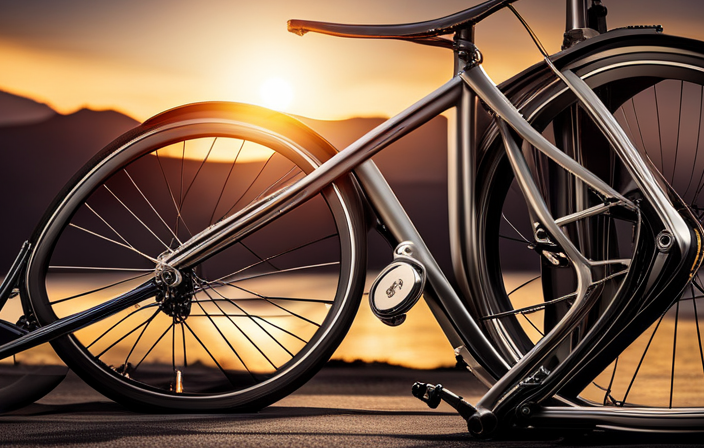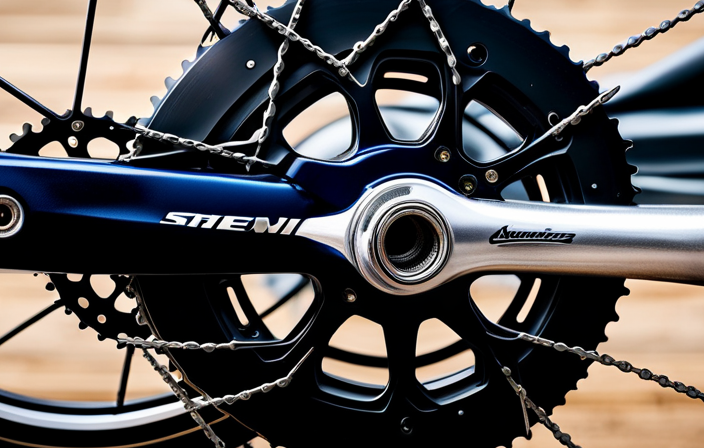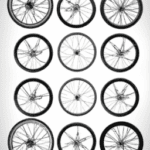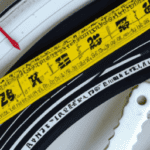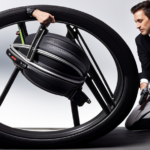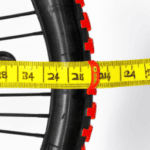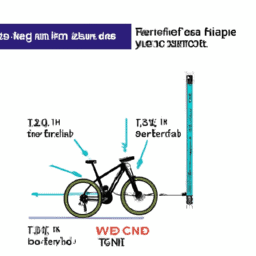Choosing the correct size bicycle wheel can greatly affect your biking experience. It’s crucial to have a grasp of the fundamentals before making a choice.
In this article, I will guide you through the different wheel sizes for various types of bicycles, discuss the benefits of larger and smaller wheels, and provide tips on how to measure your current wheel size.
By the end, you’ll have all the information you need to confidently choose the perfect bicycle wheel size for your needs.
Key Takeaways
- Riding style and terrain should be considered when selecting a wheel size for a bicycle.
- Hybrid bikes provide a balance between road and mountain biking and offer comfort and performance.
- Wheel size affects bike handling and stability, and larger wheels provide a smoother ride while smaller wheels offer better maneuverability.
- Personal preferences, body measurements, and test riding different wheel sizes can help determine the optimal wheel size for comfort.
The Basics of Bicycle Wheel Sizes
The size of a bicycle wheel depends on the type of bike you have. Understanding tire pressure and choosing the right rim width are important factors to consider when determining the size of your bicycle wheel.
Tire pressure affects the performance and comfort of your ride. Higher pressure provides less rolling resistance, while lower pressure offers better traction and shock absorption.
Rim width is also crucial for a proper fit. It affects the stability and handling of your bike. Wider rims provide better support for wider tires, improving grip and stability. On the other hand, narrower rims are suitable for narrower tires and increase aerodynamics.
When considering the size of your bicycle wheel, it’s essential to understand both tire pressure and rim width to ensure a smooth and efficient ride.
Now, let’s move on to understanding wheel diameter and width.
Understanding Wheel Diameter and Width
To figure out the right fit for your ride, you should understand the diameter and width of your bike’s wheel. The wheel diameter refers to the size of the wheel from one edge to the other. It plays a crucial role in determining the overall size and ride characteristics of your bike.
On the other hand, the tire width refers to the width of the tire that fits onto the wheel. It affects the stability, traction, and comfort of your ride. When choosing a wheel diameter and tire width, consider the type of riding you’ll be doing, your weight, and personal preferences.
Different wheel sizes work better for different types of bicycles such as road bikes, mountain bikes, and city bikes. Understanding these factors will help you make an informed decision about the right wheel size for your bike.
Different Wheel Sizes for Different Types of Bicycles
For each type of bike, there are specific wheel sizes that work best. When it comes to BMX bikes, finding the right wheel size is crucial for optimal performance. BMX bikes typically have smaller wheels, ranging from 16 to 20 inches in diameter. These smaller wheels provide better maneuverability and allow riders to perform tricks and stunts with ease. On the other hand, gravel bikes benefit from larger wheel sizes. With larger wheels, typically ranging from 27.5 to 29 inches in diameter, gravel bikes can handle rough terrains more efficiently. The larger wheel size improves stability and traction, allowing riders to conquer uneven surfaces with confidence. Transitioning into the subsequent section, the benefits of larger wheel sizes extend beyond just gravel bikes.
Benefits of Larger Wheel Sizes
Having larger wheels on your bike will enhance your riding experience and give you more confidence on various terrains.
Advantages:
- Improved traction: Larger wheels have a larger contact patch with the ground, providing better grip and stability.
- Smoother ride: The increased diameter of the wheels allows them to roll over obstacles more easily, resulting in a smoother ride.
- Increased momentum: Larger wheels retain their momentum better, allowing you to maintain speed more efficiently.
Disadvantages:
- Heavier weight: Larger wheels are generally heavier, which can make the bike feel less nimble and slower to accelerate.
- Reduced maneuverability: The larger diameter can make it slightly harder to navigate tight corners or switch directions quickly.
- Limited compatibility: Not all bike frames can accommodate larger wheel sizes, so you need to ensure your frame is compatible.
Transitioning to the next section about the benefits of smaller wheel sizes, it is important to consider the advantages and disadvantages of both options to make an informed decision.
Benefits of Smaller Wheel Sizes
Smaller wheels offer increased agility and maneuverability on tight corners and quick directional changes. The advantages of smaller wheel sizes become apparent when navigating through crowded urban areas or tackling technical trails with sharp turns.
With a smaller wheel size, you can easily change direction and maneuver around obstacles with precision. Additionally, smaller wheels provide a lower center of gravity, which enhances stability and control, especially on steep descents.
However, there are some disadvantages to consider. Smaller wheels may not roll as smoothly over rough terrain, and they can be less efficient on long, straight stretches of road. It is important to find the right balance between agility and stability when choosing the wheel size that suits your riding style and preferences.
Moving on to finding the right wheel size for your height and body type, it is crucial to consider various factors…
Finding the Right Wheel Size for Your Height and Body Type
When it comes to finding the right wheel size for your height and body type, there are a few factors to consider. First and foremost, you’ll want to take into account the type of bike you’ll be riding. For e-bikes, choosing the right wheel size is crucial for optimal performance and efficiency.
A larger wheel size can provide better traction and stability, while a smaller wheel size can offer quicker acceleration and maneuverability.
For touring bikes, there are additional factors to consider. The terrain you’ll be riding on plays a significant role in determining the ideal wheel size. Smaller wheels are better suited for rough terrain and off-road adventures, while larger wheels are more suitable for smooth roads and long-distance touring.
When choosing the right wheel size, it’s important to find a balance between comfort, performance, and personal preference. Ultimately, the right wheel size will depend on your specific needs and riding style.
Now, let’s delve into the considerations for road bikes and how to find the perfect fit.
Considerations for Road Bikes
To find the perfect fit for your road bike, it’s important to consider a few key factors.
One of the most important considerations is finding the ideal tire pressure. This can greatly affect the performance and comfort of your ride. It’s recommended to check the manufacturer’s recommendations for your specific bike model and adjust accordingly.
Another factor to consider is choosing the right spoke count. The number of spokes on your wheels can impact the overall strength and durability of your bike. Generally, road bikes have fewer spokes to reduce weight and improve aerodynamics. However, if you are a heavier rider or plan on carrying heavy loads, opting for a higher spoke count might be a better choice.
When transitioning to considerations for mountain bikes, it’s important to take into account the specific needs and terrain of off-road riding.
Considerations for Mountain Bikes
One important consideration for mountain bikes is the type of suspension you prefer. Mountain bikes typically come with either a hardtail suspension or a full suspension. A hardtail bike has a suspension fork in the front but no rear suspension, while a full suspension bike has both front and rear suspension. The type of suspension you choose will affect the performance and comfort of your ride.
When it comes to mountain bike wheel size, there are several factors that can affect your selection. The most common wheel sizes for mountain bikes are 26-inch, 27.5-inch, and 29-inch. Smaller wheel sizes like 26-inch provide nimble handling and are better suited for technical terrain, while larger wheel sizes like 29-inch offer improved stability and roll over obstacles more easily.
Considerations for selecting the right mountain bike wheel size include your riding style, the type of terrain you’ll be riding on, and your body size and strength. It’s important to choose a wheel size that matches your riding preferences and allows you to tackle the trails with confidence.
Now let’s move on to the considerations for hybrid bikes.
Considerations for Hybrid Bikes
Hybrid bikes offer a versatile option for riders seeking a blend of comfort and performance. With their combination of features from both road and mountain bikes, they provide numerous advantages.
One advantage is their ability to handle a variety of terrains, making them suitable for both on-road and light off-road riding. Another advantage is their more upright riding position, which provides better visibility and reduces strain on the back and neck.
When it comes to hybrid bike tire options, riders have a range of choices. They can opt for wider tires with more traction for off-road adventures or choose narrower tires with less rolling resistance for smoother rides on paved roads.
Considering these factors, hybrid bikes provide the perfect balance for those who enjoy a mix of both worlds.
As we move on to considerations for commuter bikes, it’s important to keep in mind the specific needs of urban riders.
Considerations for Commuter Bikes
When choosing a commuter bike, it’s important to consider factors such as comfort, durability, and storage options. One crucial aspect to keep in mind is finding the right wheel size for different terrains.
Larger wheels, typically around 700c, are great for city commuting as they provide a smoother ride and roll over obstacles more easily. Smaller wheels, like 26-inch, are better suited for rougher terrains or if you plan to carry heavy loads.
The impact of wheel size on bike handling and stability cannot be underestimated. Smaller wheels offer better maneuverability in crowded areas, while larger wheels provide more stability at higher speeds. Remember, the size of your bike’s wheels can greatly affect how it handles on the road.
Now, let’s dive into the next section about considerations for kids’ bikes.
Considerations for Kids’ Bikes
To choose the right bike for your child, think about their age, height, and riding experience. Kids’ bike sizing is determined by the wheel size, which can range from 12 inches to 24 inches. The wheel size affects the overall stability and maneuverability of the bike, so it’s important to consider a few factors when choosing.
First, consider your child’s age and height. Younger children with less experience may benefit from smaller wheel sizes for better control. As they grow and gain confidence, you can gradually increase the wheel size.
Additionally, consider the type of riding your child will be doing. If they will primarily ride on smooth pavement, a larger wheel size may be suitable. On the other hand, if they will be riding on uneven terrain, a smaller wheel size may provide more stability.
Now, let’s talk about how to measure your current wheel size.
How to Measure Your Current Wheel Size
Measuring your current wheel size is a simple process that can help you choose the right bike for your child. To get an accurate measurement, follow these techniques:
-
Use a tape measure: Measure the diameter of the wheel from one end to the other, including the tire.
-
Look for markings: Some wheels have the size printed on the side, making it easy to determine the size.
-
Check the tire: Look for a number printed on the sidewall of the tire, indicating the size.
-
Count the spokes: Count the number of spokes on the wheel, as this can also give you an idea of the wheel size.
It’s important to note that common misconceptions about wheel size can lead to choosing the wrong bike.
Now that you know how to measure your current wheel size, let’s explore how to choose the right wheel size for upgrades or replacements.
How to Choose the Right Wheel Size for Upgrades or Replacements
Determining the appropriate wheel size for upgrades or replacements can greatly enhance your biking experience.
When it comes to finding the perfect wheel size for racing, there are a few factors to consider. First, the size of your frame plays a crucial role in determining the wheel size that will fit properly. It’s important to consult with a knowledgeable bike shop or do some research to ensure compatibility.
Additionally, the impact of wheel size on bike handling and performance should not be overlooked. Smaller wheels tend to offer better acceleration and maneuverability, while larger wheels provide more stability and a smoother ride. Ultimately, the choice will depend on your personal preferences and the type of riding you do.
Now, let’s move on to the next section where I will share some tips for maintaining and caring for your bicycle wheels.
Tips for Maintaining and Caring for Your Bicycle Wheels
When it comes to taking care of your bike wheels, it’s important to regularly clean and inspect them for any signs of damage or wear. Proper maintenance and care can extend the lifespan of your wheels and ensure optimal performance. Here are some maintenance tips to keep your bicycle wheels in top condition:
-
Clean your wheels regularly using mild soap and water. Avoid using harsh chemicals or high-pressure washers as they can damage the rims.
-
Inspect the spokes for tension and trueness. Tighten any loose spokes and replace any damaged ones to maintain wheel stability.
-
Lubricate the wheel bearings periodically to prevent friction and ensure smooth rotation.
By following these maintenance tips, you can prolong the life of your bicycle wheels and enhance your riding experience. With well-maintained wheels, you’ll have a safer and more enjoyable ride. In the next section, we will discuss some final thoughts and recommendations for choosing the right bicycle wheel size.
Final Thoughts and Recommendations for Choosing the Right Bicycle Wheel Size
To ensure a comfortable and efficient ride, it’s important to consider factors like your riding style and terrain when selecting the right bicycle wheel size for you.
When it comes to choosing the right wheel size for performance, it’s crucial to strike a balance between agility and stability. Smaller wheel sizes, such as 26 inches, are generally more maneuverable and responsive, making them suitable for off-road trails and mountain biking.
On the other hand, larger wheel sizes, like 29 inches, offer better traction and roll over obstacles more easily, making them a popular choice for cross-country riding.
Determining the optimal wheel size for comfort depends on your body measurements and preferences. Taller riders may benefit from larger wheels, as they provide a smoother ride and improve stability.
Ultimately, it’s important to test ride different wheel sizes to find the one that suits your needs and enhances your riding experience.
Frequently Asked Questions
Can I use a different wheel size on my bicycle than what is recommended?
Using a smaller wheel size on a mountain bike can offer quicker acceleration and maneuverability, but may sacrifice stability and obstacle clearance. On a road bike, wheel size affects maneuverability by influencing handling and responsiveness.
Are larger wheel sizes always better for speed and performance?
Larger bicycle wheel sizes can improve speed and performance due to increased momentum and stability. However, there are trade-offs. Larger wheels can be heavier and may affect maneuverability. It’s important to consider your specific needs and terrain before choosing a wheel size.
How do I determine the wheel size of my current bicycle?
To determine the wheel size of your current bicycle, measure the diameter of the wheel. Use a tape measure to measure from one side of the tire to the other, passing through the center. Then, convert the measurement to the appropriate format to determine the wheel size.
What are the advantages of smaller wheel sizes for certain types of bicycles?
Smaller wheel sizes offer several advantages for certain types of bicycles. They provide improved maneuverability, faster acceleration, and better control. Additionally, smaller wheels are lighter and allow for easier storage and transportation.
What factors should I consider when choosing the right wheel size for upgrades or replacements?
When choosing the right wheel size for upgrades or replacements, consider the wheel size comparison and the impact of wheel size on handling. These factors play a crucial role in determining the overall performance and feel of your bike.
Conclusion
In conclusion, choosing the right bicycle wheel size is crucial for optimal performance and enjoyment of your ride.
From understanding the basics of wheel sizes to measuring your current wheel size, this article has provided you with the necessary information to make an informed decision.
Remember, bigger wheels offer benefits such as increased stability and speed, while smaller wheels provide agility and maneuverability.
So, whether you’re considering an upgrade or replacement, take the time to choose wisely and maintain your wheels to ensure a smooth and enjoyable cycling experience.
As the saying goes, "The wheels of progress keep turning."
